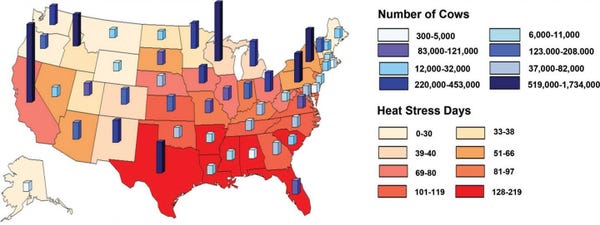Heat stress in gestating dairy cows creates generational effects
Daughters and granddaughters of heat-stressed cows show worse survival rates, length of productive life span and milk performance.
July 16, 2020

It is estimated that environmental heat stress in cows costs the U.S. dairy industry more than $1.5 billion annually due to decreased milk production, impaired reproductive performance, increased rates of illness and shortened life spans, according to an announcement from the publishers of the Journal of Dairy Science.
What effects does heat stress in pregnant cows have on the productivity and health of their female offspring in the future, and how much might this affect dairy producers' costs?
In a recent article appearing in the Journal of Dairy Science, scientists from the University of Florida and the University of California-Davis investigated the performance and profitability of two future generations of cows born to mothers exposed to heat stress during pregnancy.
According to senior author Dr. Jimena Laporta of the University of Florida department of animal sciences, previous research has found that heifers born to cows that are heat-stressed during late gestation grow to be smaller and produce, on average, 5 kg less milk per day in their first lactation compared with heifers born to dams that were cooled during the hottest days of the year.
"This suggests a permanent effect of fetal environment on genetic expression in adulthood," Laporta said. "We hypothesized that exposure of pregnant cows to heat stress during late gestation will impair daughters' and granddaughters' lifetime performances."
The researchers' first objective was to measure the carryover effects of maternal exposure to heat stress during late gestation on milk yield, reproductive performance and survival rates of daughters and granddaughters. Their second goal was to estimate the economic losses related to those outcomes across the U.S.
Laporta and colleagues pooled and analyzed a 10-year period of data collected on the performance of Holstein cows in Florida, the state with the greatest number of heat stress days per year. This gave them information on the life span, productivity and reproductive performance of two successive generations of cows born to dams exposed to heat stress during pregnancy and those born to dams that were provided with active cooling during heat stress periods, the announcement said.

The researchers found that, as expected, the daughters and granddaughters of heat-stressed cows showed negative effects in rates of survival from birth to first calving, length of productive life span and milk performance, including milk yields and nutrient contents through the first three lactations. The team calculated that these impairments translate to considerable annual costs to dairy producers in the U.S., with nationwide losses of up to $595 million annually (based on the U.S. average milk price from 2010 to 2015).
Laporta noted that lactating cows tend to be the focus of heat reduction strategies, possibly because the effects of overheating are more immediately evident among them than among non-lactating pregnant cows, for which the damage may become apparent only later when they resume milking.
However, considering the hidden costs that carry over to future generations of cows and the likelihood of increased heat stress due to ongoing climate change, Laporta and colleagues consider cooling techniques for dry cows — such as the use of fans and sprinkler systems — crucial to the continued success of the U.S. dairy industry.
The Journal of Dairy Science is published by the American Dairy Science Assn.
You May Also Like



